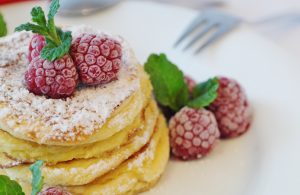4.5 The Particle と (to) and Conjunction それから (sorekara)
This module will explain the usage of the particle と (to) and the conjunction それから (sorekara). Although both can be translated as ‘and’ in English, there is a functional difference between them.
To cut to the chase, the particle と (to) is used to connect nouns or noun phrases together, indicating a combination, addition or listing of items. In contrast, the conjunction それから (sorekara) is used to connect sentences or ideas in a sequential manner, indicating a progression or continuation of thoughts.
Now, let’s take a closer look at the differences between these two language elements.
The particle と (to)
と is one of the most commonly used particles in Japanese, and it has several different functions. One key function is to indicate a complete list of multiple items.
For example, to order one coffee, one orange juice and two pancakes, you would say:

コーヒー(こおひい)一(ひと)つと、オレンジジュース(おれんじじゅうす)一つと、パンケーキ(ぱんけえき)二(ふた)つをお願(ねが)いします。
Koohii hitotsu to, orenji juusu hitotsu to, pankeeki futatsu o onegai shimasu.
One coffee, one orange juice and two pancakes, please.
Here are the formulas for using the particle と with multiple items:
X と Y をお願いします。
X to Y o onegai shimasu.
X and Y, please.
X と Y と Z をお願いします。
X to Y to Z o onegai shimasu.
X, Y and Z, please.
Here, the particle と is used to connect the items being ordered. It is important to note that this particle can only be used to connect nouns. In other words, it cannot be used to connect words that are not nouns, such as adjectives and verbs. It cannot not be used to connect clauses, phrases or sentences either.
The conjunction それから (sorekara)
The conjunction それから is used to indicate a sequence of events or ideas. It is commonly translated as ‘and then’ or ‘in addition’ in English.
It is important to note that, unlike the particle と, それから does not directly connect nouns. Instead, it connects entire sentences or clauses, indicating a continuation or progression in the narrative. For example:

ラテ(らて)をください。それから、パンケーキ(ぱんけえき)もお願いします。
Rate o kudasai. Sorekara, pankeeki mo onegai shimasu.
Please give me a latte. And then, I will have a pancake, too.
Here is the formula for using the conjunction それから with multiple items:
それから、X もお願いします。
Sorekara, X mo onegai shimasu.
And then, X as well, please.
Exercise 1

